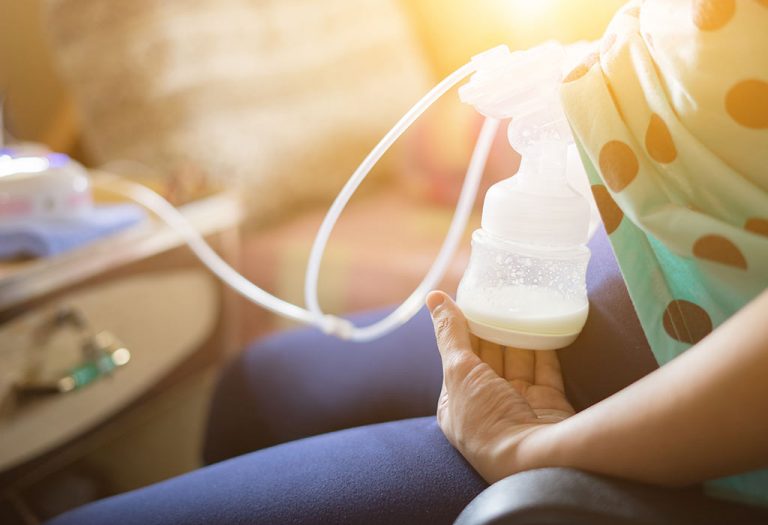Power Pumping – How Does It Help in Increasing Milk Supply?

Most breastfeeding moms are required to feed their babies consistently, which helps keep the breast stimulated to produce large quantities of milk. This frequent feeding not only ensures that the baby receives the nourishment they need but also plays a crucial role in maintaining milk supply. However, not all babies need continuous feeding, and some babies may naturally space out their feeds without affecting their growth or health. Similarly, not all lactating moms have a high supply of breast milk due to various reasons such as hormonal imbalances, stress, or health conditions. In such cases, power pumping can become an alternate and effective way to increase milk production. This method involves pumping in a specific pattern to mimic cluster feeding, allowing moms to build a stronger milk supply over time and ensure they have enough milk for their baby’s needs.
What Is Power Pumping?
Here’s power pumping meaning. Breast pump power pumping (also called cluster pumping) is an effective means usually employed by breastfeeding moms to improve their low supply of breast milk. It tries to mimic a baby’s tendency to cluster feed, wherein he clings to the breast, suckling on and off in an attempt to get more milk, which is likely to send a message to the body that more milk is required, resulting in a boost in production.
Power pumping uses a breast pump to empty the breast with rapid pumping, which helps in creating increased artificial demand. It is a way to trick the nursing mom’s body into assuming that it is required to yield more milk. The frequent pumping may signal the body to escalate the milk production.
Is Power Pumping Safe?
Most breastfeeding moms can do it easily and safely at their convenience. It does not involve taking any special medications or supplements. However, nursing moms who have no breast milk supply complications should not attempt power-pumping, as it can lead to oversupply problems.
Why Should Breastfeeding Mothers Prefer Power Pumping?
The ideal way to heighten breast milk production may be naturally through nursing on demand of a baby. But sometimes, certain factors like a baby facing issues with latching or feeling disinterested in constant breastfeeding may negatively impact nursing on demand, causing a dip in the milk supply. A breastfeeding mom may not be available to feed her baby regularly due to health reasons or job compulsions. Also, during growth spurts, a baby may require more milk than usual. In such instances, cluster pumping to increase milk supply may be a feasible option. There are many benefits of power pumping. Power pumping while nursing aims at heightening the milk supply by repetitively pumping the breast. The continual draining of the breasts may gesture the body to generate more milk using half the time.
How to Choose a Breast Pump for Power Pumping?
A dual electric pump may make a good choice for power pumping. A solo breast pump can also do the needful but may not be as efficient as a dual electric pump timewise. A single pump can use double the time to do the required job, due to which a nursing mom may have to disregard the rest period. Also, it may be wise to choose a double pump as it can offer a stronger stimulation which is likely to facilitate more milk supply. Studies indicate that the hormone prolactin which plays a significant role in making milk may get substantially elevated when nursing moms double pump.
How to Power Pump Breast Milk?
Some key points to take note of are:
- For power pumping a breast, the nursing mom may want to first sit down in a comfortable position.
- The total amount of time spent on power pumping need not be precise and can vary.
- For favourable results, a breastfeeding mom may like to commit a minimum one hour of power pumping each day.
- She can also do it for up to two times in a day to extract maximum benefit out of it or until the milk supply is adequate to cater to the baby’s nursing demands.
- Breast power pumping can be done anytime as per the mother’s convenience.
- A relaxed state of mind normally helps. Stress, anxiety, panic can adversely affect breast milk production.
- It is also highly effective when it corresponds with a healthy diet and plenty of rest. Therefore a good time for power pumping can be when a nursing mom is relaxing after a nourishing meal or the baby is sleeping or occupied elsewhere.
- Research suggests that milk volume is naturally higher in the morning. It tends to reduce slowly through the day. Hence, power pumping session done in the morning may foster better results.
Power Pumping Schedule to Increase Milk Supply
If you’re struggling with a low milk supply or want to boost your production, power pumping can be a helpful solution. Here are three examples of power pumping schedules explaining when to power pump:
Option 1
- Pump for 20 minutes
- Rest for 10 minutes
- Pump for 10 minutes
- Rest for 10 minutes
- Pump for 10 minutes
Option 2
- Pump for 15 minutes
- Rest for 5 minutes
- Pump for 10 minutes
- Rest for 5 minutes
- Pump for 10 minutes
- Rest for 5 minutes
- Pump for 10 minutes
Option 3
- Pump for 15 minutes
- Rest for 10 minutes
- Pump for 5 minutes
- Rest for 5 minutes
- Pump for 5 minutes
When Can You Stop Power Pumping?
Every nursing mom’s body can be different. Some lactating moms can experience improved results in a few days (two to three days), while others may require to indulge in power pumping for a longer duration of time (for a week or more) to have increased supply. So how long one may continue power pumping generally depends on the way their body typically responds.
Tips to Make Power Pumping Easier
Here are some useful tips which may make power pumping easier.
- Allow yourself the pleasure of doing something you enjoy while you power pump, like listening to soothing music, watching your favourite show or reading a book. A happy you will bring out the best results.
- Set up a pumping station which has everything that you may need during a pumping session, as you will be at it for a while.
- Choose an agreeable and comfortable spot like your bedroom or a cosy couch where you can relax completely.
- Wearing a hands-free bra can be a convenient option for pumping sessions.
- Try and power pump when your baby is taking his nap. In case he is awake, make sure you have help around. Managing a baby and power pumping together at the same time may not be a good idea.
- You may like to double pump for quicker results instead of using single pumping. It also saves you a lot of time.
- It is necessary to keep an eye on your power pumping time and schedule to avoid overdoing it.
- Keep lots of water handy for staying properly hydrated is vital for maintaining milk supply.
- You can also utilise the time to eat a healthy snack like some fruit, dry fruits or even chocolate.
- Try and avoid unnecessary anxiety or stress, as excessive stress can interfere with the production of oxytocin which is mainly responsible for the let-down reflex or the free flow of milk from the breast.
- In case of chafing or cracking of the skin around the nipples, applying coconut oil or a safe nipple cream may prove beneficial.
- Viewing the time devoted to power-pumping as a chance to wind down instead of another task may help you to stay positive and upbeat about the whole thing.
Who Should Avoid Power Pumping?
Power pumping to increase supply is not suitable for everyone. Mothers with an overactive milk supply should avoid it, as it can lead to engorgement, plugged ducts, or mastitis. It’s also not recommended for those experiencing breast or nipple pain, as it may exacerbate discomfort. Mothers with low milk supply due to underlying medical conditions, like hormonal imbalances or insufficient glandular tissue, may not see significant results from power pumping alone and should seek professional advice. Additionally, mothers with limited time, high stress, or who are unwell should consider other methods, as power pumping requires energy and a time commitment that could be too overwhelming.
FAQs
1. Can power pumping cause dehydration?
Power pumping itself does not cause dehydration, but the increased milk production could lead to more fluid loss. It’s important to stay well-hydrated during the process by drinking plenty of water to support milk supply and overall health.
2. Should I power pump if I’m supplementing with formula?
If you’re supplementing with formula but still want to increase your breast milk supply, power pumping can be beneficial. It helps signal your body to produce more milk, potentially reducing your reliance on formula over time. However, it’s important to do so under the guidance of a lactation consultant.
3. Can power pumping be done while traveling or on the go?
While power pumping is typically done at home, it can be done while traveling with the right equipment, such as a portable breast pump. Just ensure you have enough time and a private space to complete the process comfortably.
Power pumping breast milk can be helpful in stimulating milk supply. However, it is not advisable to skip feeding your baby to power pump. A baby nursing at the breast is any day a better choice for generating milk than a breast pump. In any case, it is always sensible to consult your doctor before resorting to power pumping. It is quite possible that you already have enough breast milk for your baby but may not know it.
References/Resources:
1. “Power-Pumping” – Super Stimulation For Milk Production; European Lactation Consultants Alliance; https://cdn.website-editor.net/fbecae35f0d04078b90baf90c3032ed5/files/uploaded/EN%20Power-Pumping.pdf
2. Increasing your supply; Australian Breastfeeding Association; https://www.breastfeeding.asn.au/resources/increasing-supply
3. Power Pumping; NHS Alder Hey Children’s https://www.alderhey.nhs.uk/wp-content/uploads/2023/06/Power-Pumping-Breastfeeding-Leaflet-PIAG-341.pdf
4. Breastfeeding FAQs: Supply and Demand; Nemours Kids Health; https://kidshealth.org/en/parents/breastfeed-supply.html
5. Feeding your newborn: Tips for new parents; Mayo Clinic; https://www.mayoclinic.org/healthy-lifestyle/infant-and-toddler-health/in-depth/healthy-baby/art-20047741
6. Kalathingal. T, Manerkar. S, Mondkar. J, Kalamdani. P, et al.; Comparison of Two Pumping Strategies to Improve Exclusive Breastfeeding at Discharge in Mothers of VLBW Infants with Low Milk Output – A Pilot Randomized Controlled Trial (Indian Journal of Pediatrics); National Library of Medicine; https://pubmed.ncbi.nlm.nih.gov/37794310/; September 2024
7. Devi. U, Adhisivam. B; Pumping Strategies to Improve Exclusive Breastfeeding (Indian Journal of Pediatrics); Springer Nature Link; https://link.springer.com/article/10.1007/s12098-024-05188-w; June 2024
Also Read:
Pumping Milk before Birth
How to Pump and Store Breast Milk
Breastfeeding and Pumping Schedule
Was This Article Helpful?
Parenting is a huge responsibility, for you as a caregiver, but also for us as a parenting content platform. We understand that and take our responsibility of creating credible content seriously. FirstCry Parenting articles are written and published only after extensive research using factually sound references to deliver quality content that is accurate, validated by experts, and completely reliable. To understand how we go about creating content that is credible, read our editorial policy here.
























